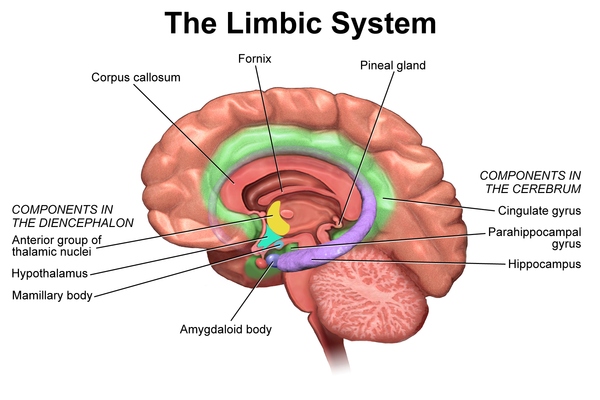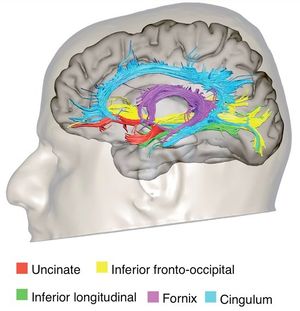Limbic System
Original Editor - User Name
Top Contributors - Lucinda hampton, Stacy Schiurring, Kim Jackson and Rucha Gadgil
Introduction[edit | edit source]
The limbic system is a set of structures of the brain. These structures cover both sides of the thalamus, right under the cerebrum. It is not a separate system, but a collection of structures from the cerebrum, diencephalon, and midbrain. It supports many different functions, including emotion, behaviour, motivation, long-term memory, and olfaction.[1]
It combines higher mental functions and primitive emotion into a single system often referred to as the emotional nervous system. It is not only responsible for our emotional lives but also our higher mental functions, such as learning and formation of memories. The limbic system is the reason that some physical things such as eating seem so pleasurable to us, and the reason why some medical conditions, such as high blood pressure, are caused by mental stress. There are several important structures within the limbic system: the amygdala, hippocampus, thalamus, hypothalamus, basal ganglia, and cingulate gyrus.[2]
The limbic system is among the oldest parts of the brain in evolutionary terms: it can be found in fish, amphibians, reptiles and mammals.
Image: Components of the Limbic System.
Important Limbic Structures[edit | edit source]
All the components of the limbic system work together to regulate some of the brain’s most important processes. The components are listed below:
Image: Tractography reconstructions of the limbic pathways.
The Amygdala
- Small almond-shaped structure; there is one located in each of the left and right temporal lobes. Known as the emotional center of the brain, the amygdala is involved in evaluating the emotional valence of situations (e.g., happy, sad, scary). It helps the brain recognize potential threats and helps prepare the body for fight-or-flight reactions by increasing heart and breathing rate. The amygdala is also responsible for learning on the basis of reward or punishment.
- Due to its close proximity to the hippocampus, the amygdala is involved in the modulation of memory consolidation, particularly emotionally-laden memories. Emotional arousal following a learning event influences the strength of the subsequent memory of that event, so that greater emotional arousal following a learning event enhances a person’s retention of that memory.
The Hippocampus
- Found deep in the temporal lobe, and is shaped like a seahorse. It consists of two horns curving back from the amygdala. Psychologists and neuroscientists dispute the precise role of the hippocampus, but generally agree that it plays an essential role in the formation of new memories about past experiences.
The Thalamus and Hypothalamus
- Both associated with changes in emotional reactivity. The thalamus (sensory “way-station” for the rest of the brain) is primarily important due to its connections with other limbic-system structures. The hypothalamus is a small part of the brain located just below the thalamus on both sides of the third ventricle. Lesions of the hypothalamus interfere with several unconscious functions (such as respiration and metabolism) and some so-called motivated behaviors like sexuality, combativeness, and hunger. The lateral parts of the hypothalamus seem to be involved with pleasure and rage, while the medial part is linked to aversion, displeasure, and a tendency for uncontrollable and loud laughter.
The Cingulate Gyrus
- Located in the medial side of the brain next to the corpus callosum. Its frontal part links smells and sights with pleasant memories of previous emotions. This region also participates in our emotional reaction to pain and in the regulation of aggressive behavior.
The Basal Ganglia
- A group of nuclei lying deep in the subcortical white matter of the frontal lobes that organizes motor behavior[2].
Sub Heading 3[edit | edit source]
Resources[edit | edit source]
- bulleted list
- x
or
- numbered list
- x
References[edit | edit source]
- ↑ Kiddle Limbic system facts for kids Available from: https://kids.kiddle.co/Limbic_system (accessed 28.12.2020)
- ↑ 2.0 2.1 Lumen learning Structure and function of the brain Available from:https://courses.lumenlearning.com/boundless-psychology/chapter/structure-and-function-of-the-brain/ (accessed 28.12.2020)








